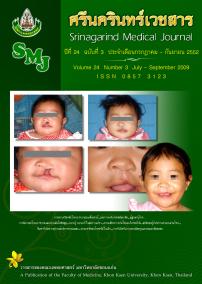ThaiScience
ThaiScience
SRINAGARIND MEDICAL JOURNAL
Volume 35, No. 03, Month MAY, Year 2020, Pages 255 - 260
Effect of lisinopril on left ventricular and vascular function in nitric oxide-deficient rats
Metee Iampanichakul, Nisita Chaihongsa, Benchaporn Saengnak, Weerapon Sangartit, Putcharawipa Maneesa, Parichat Prachaney, Poungrat Pakdeechote
Abstract Download PDF
Background and Objective: Lisinopril, angiotensin- converting enzyme inhibitors (ACEIs), is widely used to treat hypertension and heart failure. This study investigated whether lisinopril could prevent Nω-Nitrol- arginine methyl ester (L-NAME)-induced hypertension, left ventricular (LV) and vascular dysfunction in rats. Methods: Male Sprague-Dawley rats were treated with L-NAME (40 mg/kg/day) in drinking water only or together with lisinopril (2.5 mg/kg/day) for five weeks while control rats received distilled water (n=5). Blood pressure and cardiac function were measured. Aortic rings were isolated for vascular function test. Results: Rats treated with L-NAME had high blood pressure and impairment of cardiac function and acetylcholine (ACh)-induced vasorelaxation in isolated aortic rings. Vascular response to sodium nitroprusside (SNP) did not differ among groups. Interestingly, lisinopril significantly prevented L-NAME-induced hypertension and alleviated L-NAME-induced cardiac and vascular dysfunction (p<0.05). Conclusion: These findings suggested that lisinopril prevented the development of hypertension and partially prevented cardiac and vascular endothelial dysfunction induced by L-NAME.
Keywords
Lisinopril, L-NAME-induced hypertensive rats, Cardiac and vascular dysfunctionSRINAGARIND MEDICAL JOURNAL
Published by : Faculty of Medicine, Khon Kaen University
Contributions welcome at : http://www.smj.ejnal.com/e-journal/journal/index.php
